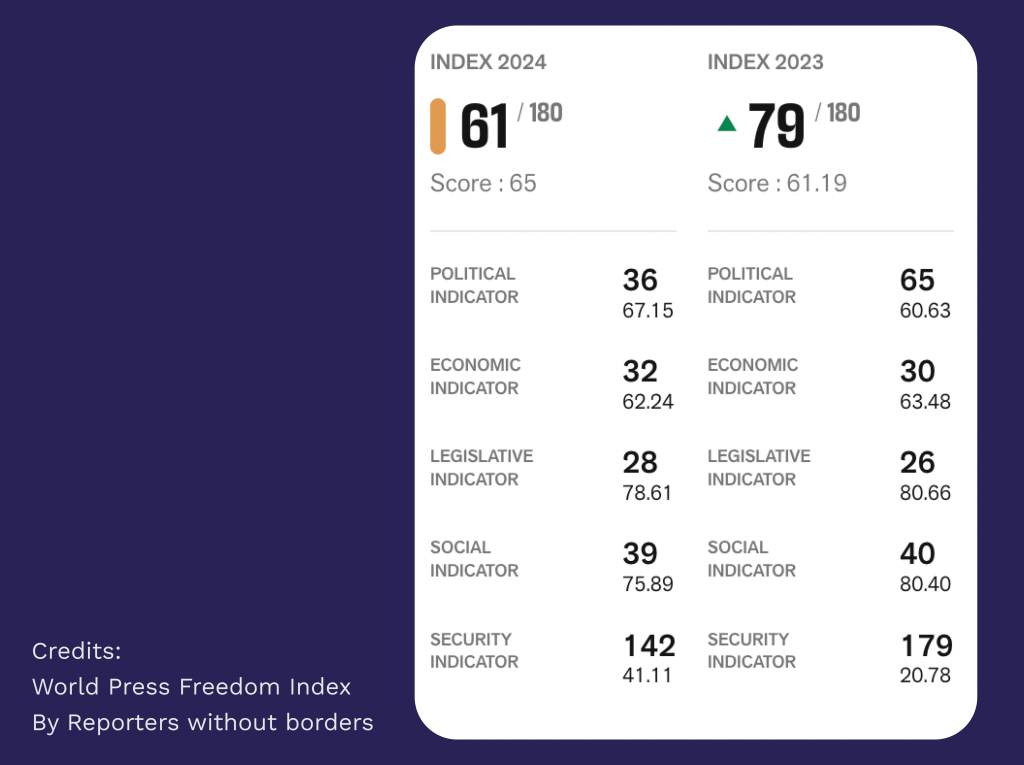
“One of the Index’s surprises is the 18-place jump by Ukraine (61st) due to improvements in both its security indicator – fewer journalists killed – and its political one. Although the rule of law has not been enforced over the entire country since the Russian invasion, which has prevented the Ukrainian authorities from guaranteeing press freedom in the occupied territories, political interference in free Ukraine has fallen. This kind of pressure is limited by the fact that the media denounce it,” the report’s narrative reads.

The report provides detailed information on the research and methodology that influenced the rating.
Ukraine’s media landscape is diverse, but remains partly in the grip of oligarchs, who own the majority of the national TV channels. The state has also become a central media actor since the Russian invasion in February 2022. The media sector is bearing the brunt of the impact of the Russian invasion, disrupting the work of newsrooms and even jeopardizing their economic survival. In territories under Russian control – Crimea, annexed in 2014, along with Donbass and areas occupied by the Russian army in 2022 – the Ukrainian media is being silenced and replaced by Kremlin propaganda.
Even before the military confrontation, the “information war” with Russia maintained a poisonous climate in Ukraine: the banning of media regarded as pro-Kremlin by presidential decree and the restriction of access to Russian social media, among other things, have intensified since the Russian invasion. Media outlets relaying Russian propaganda have been blocked, while the Russian army has deliberately targeted journalists, media outlets and telecommunications infrastructure to prevent the Ukrainian population from having access to independent news and information.
Since the 2014 Revolution of Dignity, several sets of laws have been adopted on media transparency, access to information and the protection of journalists. The creation of the independent public broadcaster Suspilne in 2017 has been one of the most emblematic of these reforms. A new media law that was adopted in late 2022 after years of preparation has brought Ukraine in line with European legislation. The application of martial law sometimes results in reporting restrictions for journalists, especially on the frontline.
The Russian invasion has weakened the Ukrainian economy and has caused media outlets to lose many subscribers and advertisers. Combined with other consequences of the war, such as material destruction, the disruption of supply chains and the forced exile of employees, this situation is threatening the survival of many Ukrainian media. Several hundred media outlets have had to close, while others have reduced their activity and temporarily laid-off their employees without pay. Local and print media have been the most affected in the face of these challenges.
The war profoundly changed the work of journalists and the stories they cover. The Russian attacks taking place throughout the country have turned them all into war reporters. The Ukrainian media, however, continue to cover social issues and to play an essential role in exposing corruption within the country’s elite, despite being under pressure. However, gender inequality in the media remains a problem, especially when it comes to giving a voice to experts on given topics – a problem that has been exacerbated since the Russian invasion.
Since the Russian invasion in February 2022, journalists’ safety has been threatened more than ever. They are sometimes deliberately targeted by military fire despite displaying their “Press” identification, and the list of reporters injured or killed, and media outlets badly damaged by airstrikes, has continued to rise. Before the war, journalists were sometimes the targets of physical violence, mainly during protests. Finally, cyberattacks, breaches of the confidentiality of sources and restriction on access to information are also matters of concern.
The Reporters without Borders report on press freedom is available here.